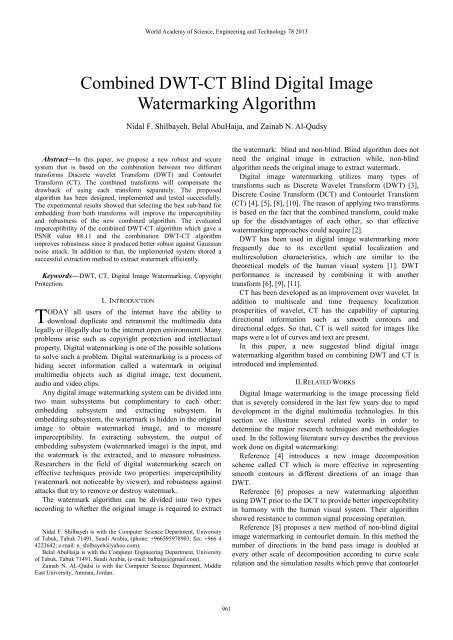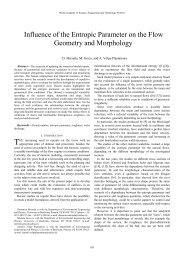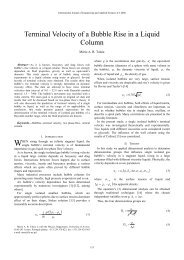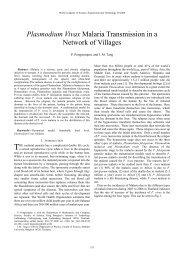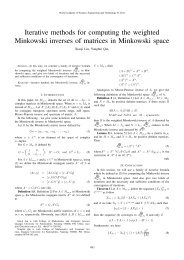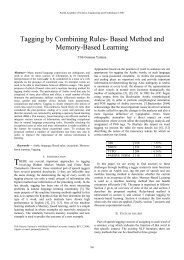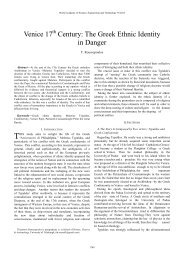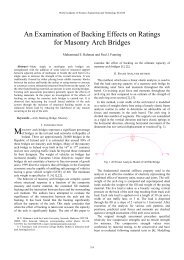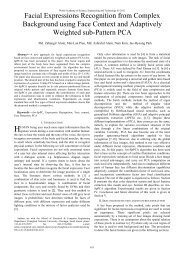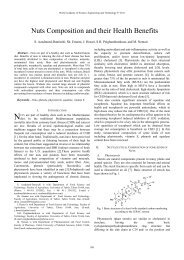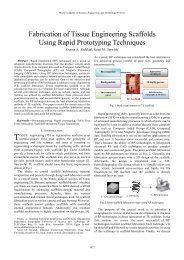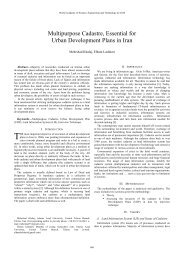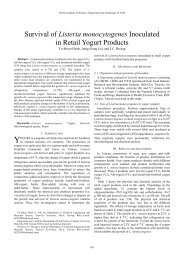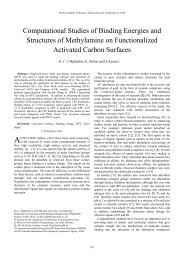Combined DWT-CT Blind Digital Image Watermarking Algorithm
Combined DWT-CT Blind Digital Image Watermarking Algorithm
Combined DWT-CT Blind Digital Image Watermarking Algorithm
You also want an ePaper? Increase the reach of your titles
YUMPU automatically turns print PDFs into web optimized ePapers that Google loves.
World Academy of Science, Engineering and Technology 78 2013<strong>Combined</strong> <strong>DWT</strong>-<strong>CT</strong> <strong>Blind</strong> <strong>Digital</strong> <strong>Image</strong><strong>Watermarking</strong> <strong>Algorithm</strong>Nidal F. Shilbayeh, Belal AbuHaija, and Zainab N. Al-QudsyAbstract—In this paper, we propose a new robust and securesystem that is based on the combination between two differenttransforms Discrete wavelet Transform (<strong>DWT</strong>) and ContourletTransform (<strong>CT</strong>). The combined transforms will compensate thedrawback of using each transform separately. The proposedalgorithm has been designed, implemented and tested successfully.The experimental results showed that selecting the best sub-band forembedding from both transforms will improve the imperceptibilityand robustness of the new combined algorithm. The evaluatedimperceptibility of the combined <strong>DWT</strong>-<strong>CT</strong> algorithm which gave aPSNR value 88.11 and the combination <strong>DWT</strong>-<strong>CT</strong> algorithmimproves robustness since it produced better robust against Gaussiannoise attack. In addition to that, the implemented system shored asuccessful extraction method to extract watermark efficiently.Keywords—<strong>DWT</strong>, <strong>CT</strong>, <strong>Digital</strong> <strong>Image</strong> <strong>Watermarking</strong>, CopyrightProtection.TI. INTRODU<strong>CT</strong>IONODAY all users of the internet have the ability todownload duplicate and retransmit the multimedia datalegally or illegally due to the internet open environment. Manyproblems arise such as copyright protection and intellectualproperty. <strong>Digital</strong> watermarking is one of the possible solutionsto solve such a problem. <strong>Digital</strong> watermarking is a process ofhiding secret information called a watermark in originalmultimedia objects such as digital image, text document,audio and video clips.Any digital image watermarking system can be divided intotwo main subsystems but complimentary to each other:embedding subsystem and extracting subsystem. Inembedding subsystem, the watermark is hidden in the originalimage to obtain watermarked image, and to measureimperceptibility. In extracting subsystem, the output ofembedding subsystem (watermarked image) is the input, andthe watermark is the extracted, and to measure robustness.Researchers in the field of digital watermarking search oneffective techniques provide two properties: imperceptibility(watermark not noticeable by viewer), and robustness againstattacks that try to remove or destroy watermark.The watermark algorithm can be divided into two typesaccording to whether the original image is required to extractNidal F. Shilbayeh is with the Computer Science Department, Universityof Tabuk, Tabuk 71491, Saudi Arabia, (phone: +966595978903; fax: +966 44223642; e-mail: n_shilbayeh@yahoo.com).Belal AbuHaija is with the Computer Engineering Department, Universityof Tabuk, Tabuk 71491, Saudi Arabia, (e-mail: balhaija@gmail.com).Zainab N. AL-Qudsi is with the Computer Science Department, MiddleEast University, Amman, Jordan.the watermark: blind and non-blind. <strong>Blind</strong> algorithm does notneed the original image in extraction while, non-blindalgorithm needs the original image to extract watermark.<strong>Digital</strong> image watermarking utilizes many types oftransforms such as Discrete Wavelet Transform (<strong>DWT</strong>) [3],Discrete Cosine Transform (D<strong>CT</strong>) and Contourlet Transform(<strong>CT</strong>) [4], [5], [8], [10]. The reason of applying two transformsis based on the fact that the combined transform, could makeup for the disadvantages of each other, so that effectivewatermarking approaches could acquire [2].<strong>DWT</strong> has been used in digital image watermarking morefrequently due to its excellent spatial localization andmultiresolution characteristics, which are similar to thetheoretical models of the human visual system [1]. <strong>DWT</strong>performance is increased by combining it with anothertransform [6], [9], [11].<strong>CT</strong> has been developed as an improvement over wavelet. Inaddition to multiscale and time frequency localizationprosperities of wavelet, <strong>CT</strong> has the capability of capturingdirectional information such as smooth contours anddirectional edges. So that, <strong>CT</strong> is well suited for images likemaps were a lot of curves and text are present.In this paper, a new suggested blind digital imagewatermarking algorithm based on combining <strong>DWT</strong> and <strong>CT</strong> isintroduced and implemented.II. RELATED WORKS<strong>Digital</strong> <strong>Image</strong> watermarking is the image processing fieldthat is severely considered in the last few years due to rapiddevelopment in the digital multimedia technologies. In thissection we illustrate several related works in order todetermine the major research techniques and methodologiesused. In the following literature survey describes the previouswork done on digital watermarking:Reference [4] introduces a new image decompositionscheme called <strong>CT</strong> which is more effective in representingsmooth contours in different directions of an image than<strong>DWT</strong>.Reference [6] proposes a new watermarking algorithmusing <strong>DWT</strong> prior to the D<strong>CT</strong> to provide better imperceptibilityin harmony with the human visual system. Their algorithmshowed resistance to common signal processing operation.Reference [8] proposes a new method of non-blind digitalimage watermarking in contourlet domain. In this method thenumber of directions in the band pass image is doubled atevery other scale of decomposition according to curve scalerelation and the simulation results which prove that contourlet961
World Academy of Science, Engineering and Technology 78 2013domain watermarking is well suited for image like mapswhere a lot of curves and texts are inherently present.Reference [1] describes imperceptible and robust combined<strong>DWT</strong>-D<strong>CT</strong> digital image watermarking algorithm and theperformance evaluation result shows that combining the twotransform improves the performance of the watermarkingalgorithm that are based solely on the <strong>DWT</strong> transform.Reference [5] investigates the role of <strong>CT</strong> versus <strong>DWT</strong> inproviding robust image watermarking. Two measures areutilized in the comparison between wavelet based andcontourlet based methods, peak signal to noise ratio (PSNR)and normalized cross correlation (NCC).Reference [9] proposes an algorithm of digital imagewatermarking based on D<strong>CT</strong> and <strong>DWT</strong> according to thecharacteristics of the human vision. In their algorithm theinformation of the digital watermark is transform using D<strong>CT</strong>embedded in the original image which is transform using<strong>DWT</strong> then embedding information of the digital watermark inthe high frequency band of the original image transformation.Reference [2] proposes a new robust digital imagewatermarking algorithm based on join <strong>DWT</strong>-D<strong>CT</strong> transforms.A binary watermarked logo is scrambled by Arnold cat mapand embedded in the certain coefficient sets of a 3-level <strong>DWT</strong>transformed of a host image. Then, D<strong>CT</strong> of each selected<strong>DWT</strong> subband is computed and the PN-sequences of thewatermark bits are embedded in the middle frequenciescoefficient of the corresponding D<strong>CT</strong> block.Reference [7] clarifies the advantages by <strong>CT</strong> versus the<strong>DWT</strong>. Prove that the Contourlet domain is suitable for imagelike maps.Reference [11] presents a new robust and secure hybridwatermark technique based on HWT and <strong>DWT</strong>. The proposedmethod is constructed by cascading two different butcomplementary techniques. Performance evaluation of theproposed method showed improved result of imperceptibility,robust and security in comparison with other systems.III. THE PROPOSED COMBINED <strong>DWT</strong>-<strong>CT</strong> DIGITALWATERMARKING ALGORITHMIn this paper, we proposes a new image watermarkingalgorithm based on combining two transforms; <strong>DWT</strong> and <strong>CT</strong>.<strong>Watermarking</strong> is done by modifying the coefficients ofcarefully selected <strong>DWT</strong> sub-band, followed by applying <strong>CT</strong>on the selected sub-band. The reason for applying the twotransforms is based on the fact that combined transforms couldcompensate for the drawbacks of each other, resulting ineffective watermarking.There are different techniques that can be used to embed thewatermark, but since using the spatial domain gives us fragilewatermarks that are not robust against the attacks, we decidedto work on the frequency domain because we are searching forwatermarking algorithms that are robust against differentkinds of attacks such the Geometrical and Removal attacks,without affecting the quality of the watermarked image, so wewere trying to solve the conflict between robustness andimperceptibility.Fig. 1 shows the sequence of the techniques we used in ouralgorithm.Spatial Domain<strong>CT</strong>2-Levels <strong>CT</strong><strong>DWT</strong>-<strong>CT</strong><strong>Watermarking</strong>TechniquesFrequency Domain<strong>DWT</strong> D<strong>CT</strong> DFT2-Levels <strong>DWT</strong>Fig. 1 <strong>Watermarking</strong> Techniques UsedA new image watermarking algorithm will be presented bycombining <strong>DWT</strong> and <strong>CT</strong> to develop a blind imagewatermarking algorithm to provide better imperceptibility andhigher robustness against variety of attacks. First, we applieda 2-level <strong>DWT</strong> to the image by choosing mid-mid sub-band.The selection to the mid-mid subband shored better results inimperceptibility. Second, we applied <strong>CT</strong> to the chosensubband to study their effects.The main reason of combing <strong>DWT</strong> and <strong>CT</strong> is to minimizethe drawbacks of each of them separately. Most researchers inthe field of digital watermarking focuses on using <strong>DWT</strong> due toits excellent spatial localization and multi-resolutionproperties, which are similar to the theoretical models ofhuman visual system. However, there are two drawbacksassociated with <strong>DWT</strong>. First, it lacks shift invariance, whichmeans small shift in input signal that can cause big changes inthe energy distribution of the wavelet coefficients. Second, the<strong>DWT</strong> has poor directional selectivity, which is evident fromthe impulse responses of the filters of the individual subbands.Fig. 2 shows Lena’s image after applying 2-level <strong>DWT</strong>followed by 2-level <strong>CT</strong>.Directionalsub-band S4Fig. 2 2-Level <strong>DWT</strong> followed by 2-Level <strong>CT</strong>The <strong>Combined</strong> <strong>DWT</strong>-<strong>CT</strong> Based watermarking <strong>Algorithm</strong>consists of two algorithms; watermark embedding andwatermark extraction.962
World Academy of Science, Engineering and Technology 78 2013A. Embedding <strong>Algorithm</strong> Based on <strong>DWT</strong>-<strong>CT</strong>The watermark embedding algorithm is shown as blockdiagram in Fig. 3 and described in details in the followingsteps.Step 1. Apply <strong>DWT</strong> to decompose the original image into fournon-overlapping multi-resolution sub-bands:LL1,HL1, LH1, and HH1.Step 2. Apply <strong>DWT</strong> again to HL1 to get four smaller subbandsand choose the HL2 sub-band for furtherdecomposition using <strong>CT</strong>.Step 3. Apply 2-level <strong>CT</strong> to selected sub-bands in step 2. Thenselect directional sub-bands to embed the watermarkon it.Step 4. Re-formulate the gray-scale watermark image into avector of zeros and ones.Step 5. Generate uncorrelated pseudorandom sequence(pn_sequence) that will be used in embedding thewatermark bit 0. Size of (pn_sequence) must be equalto the size of the chosen sub-band.Step 6. Modify the coefficients of the chosen sub-band byembedding pn_sequence with the gain factor kaccording to the equation:X=X+K* pn_sequanceHL1, LH1, and HH1.Step 2. Apply <strong>DWT</strong> again to HL1 to get four smaller subbandsand select the HL2 sub-band for furtherdecomposition by applying <strong>CT</strong>.Step 3. Apply 2-level <strong>CT</strong> to the selected sub-bands in step 2.Select directional sub-bands to embed the watermarkon it.Step 4. Re-formulate the gray-scale watermark image into avector of zeros and ones.Step 5. Generate uncorrelated pseudorandom sequence(pn_sequence) using the same seed used in thewatermark embedding algorithm.Step 6. Calculate the correlation of the chosen sub-band withthe generated pseudorandom sequence by m times,where m is the length of watermark vector.Step 7. Calculate the mean of the correlation and compare itwith each value of the correlation value that wecalculated in step 6.Step 8. If the calculated values of the correlation are greaterthan the mean, then the extracted watermark is equals0, otherwise 1.Step 9. Reconstruct the watermark using the extractedwatermark bits, and then compute the similaritybetween the original and extracted watermark.where X is the coefficient of the selected sub-band and k is thegain factor .We should find a suitable gain factor which givesthe best tradeoff between visibility and robustness.Step 7. Perform I<strong>CT</strong> using the selected sub-bands of each levelfollowed by performed I<strong>DWT</strong> and modifiedcoefficient to produce the watermarked image.KeyWatermarkFormulationPN-SequenceExtractedWatermarkOriginal image2-level<strong>DWT</strong>2-levelI<strong>DWT</strong>Watermarked imageExtractionalgorithm2-levels<strong>CT</strong>2-levelI<strong>CT</strong>Original watermark2-levels<strong>CT</strong>Original WatermarkWatermarkFormulationEmbeddingalgorithmPN-SequenceFig. 3 <strong>DWT</strong>-<strong>CT</strong> Watermark Embedding Block DiagramB. Extracting <strong>Algorithm</strong> Based on <strong>DWT</strong>-<strong>CT</strong>The <strong>DWT</strong>-<strong>CT</strong> watermark algorithm is a blind watermarkingalgorithm, and thus the extraction does not need the originalimage. The watermark extraction algorithm is shown in Fig. 4,and described in detail in the following steps:Step 1. Apply <strong>DWT</strong> to decompose the watermarked imagewhich is obtained from the embedding algorithm to getfour non-overlapping multi-resolution sub-bands: LL1,KeyFig. 4 <strong>DWT</strong>-<strong>CT</strong> Watermark Extraction Block DiagramIV. EXPERIMENTAL RESULTSThe performance of the watermarking algorithm is usuallyevaluated with respect to two properties: imperceptibility androbustness. In each section, the implementation of thealgorithm is evaluated by using two measures: Peak Signal toNoise Ratio (PSNR) which measures imperceptibility and theNormalized Cross Correlation (NCC) which measuresrobustness.A. Imperceptibility2-levels<strong>DWT</strong>The watermark signal should be imperceptible (visible) tothe end user who is viewing the watermarked image. Thismeans that the perceived quality of the image should not be963
World Academy of Science, Engineering and Technology 78 2013distorted by the presence of the watermark and a user shouldnot be able to differentiate between watermarked and originalimage.As a measure of the quality of a watermarked image, PeakSignal to Noise Ratio (PSNR) is used.To compute the Peak signal to noise ratio, first we need tocompute the Mean Square Error (MSE) as in (1) [1]:m−1 n−11MSE = ∑∑I ( i , j ) −K( i, j)mni= 0 j=0where I is the original image, K is the watermarked image thatcontain m by n pixels,PSNR calculated according to (2):2(1)of each algorithm is evaluated using Peak Signal to NoiseRatio (PSNR) which measures imperceptibility.As a sample watermark, ark, we choose the <strong>Image</strong> shown in Fig.5. The size of this image is 50x20. We used the “Lena” imageshown in Fig. 6 as the original image in which we embeddedthe watermark. . The size of this image is 512x512.Fig. 5 Sample Watermark2⎛MAX ⎞I⎛MAXI⎞PSNR = 10 ⋅ log 10 ⎜ ⎟= 20 ⋅ log10⎝ MSE⎜ ⎟⎠ ⎝ MSE ⎠ (2)Here, MAX1 is the maximum pixel value of the image.Once the PSNR exceeds some value, the errors becomeundetectable to human viewers. Conversely, the human visualsystem seems to have a saturation effect as well. Once theimage quality falls below a certain level, the image simplylooks bad.The combined <strong>DWT</strong>-<strong>CT</strong> algorithm has been tested andevaluated. Also, <strong>DWT</strong> and <strong>CT</strong> algorithms has been tested andevaluated separately for the sake of comparison. Theperformance of the watermarking algorithm is evaluated withrespect to the imperceptibility property. The implementationFig. 6 Original <strong>Image</strong>B. Searching for the Best Sub-Band in <strong>DWT</strong> and <strong>CT</strong>Embedding <strong>Algorithm</strong>s PerceptibilityWe carried out the watermark embedding algorithm basedon <strong>DWT</strong> domain only. Applied 1-level 1 <strong>DWT</strong> of the Lenaimage produced 256×256 sub-bands: LL1, LH1, HL1, andHH1. Since embedding the watermark beyond the watermarkin LH2 or HH2 is more effective. The coefficient of the LH2or HH2 sub-band band is selected for embedding process. Weevaluate the imperceptibility of the <strong>DWT</strong> algorithm bymeasuring PSNR for different sub-bands as shown in Table I.Original image1-<strong>DWT</strong>(LH 1)TABLE IPSNR VALUES AT DIFFERENT <strong>DWT</strong> SUB-BANDSWatermarked image1-<strong>DWT</strong>(HH 1)2-<strong>DWT</strong>(LH 2)2-<strong>DWT</strong>(HH 2)3-<strong>DWT</strong>(LH 3)3-<strong>DWT</strong>(HH 3)PSNR=71.28 PSNR=71.28 PSNR=80.21 PSNR=77.12 PSNR=83.26PSNR=100.97The imperceptibility of <strong>CT</strong> was tested by calculating thePSNR between the original image and the watermarked image.We embedded the watermark image in each sub-band afterapplying 1-level <strong>CT</strong>. Then we calculate the imperceptibility ofthis algorithm with the 2 and 3 levels <strong>CT</strong>. We noticed that anychange in the low frequency affected the imperceptibility ofthe image. In Table II we compared the results obtained fromembedded watermark image in different sub-bands of 1, 2, and3 levels <strong>CT</strong>.Original image1-<strong>CT</strong>Sub 01-<strong>CT</strong>Sub 1TABLE IIPSNR VALUES AT DIFFERENT <strong>CT</strong> SUBBANDSWatermarked image1-<strong>CT</strong>Sub 22-<strong>CT</strong>Sub 02-<strong>CT</strong>Sub 12-<strong>CT</strong>Sub22-<strong>CT</strong>Sub32-<strong>CT</strong>Sub 43-<strong>CT</strong>Sub 8PSNR=70.62PSNR=69.22PSNR=69.93PSNR=70.60PSNR=72.41PSNR=71.41PSNR=72.16PSNR=73.21PSNR=76.88We notice that best choice of embedding is 3-level 3 indirectional sub-band band since it produced better result inimperceptibility and we continued the work on 3-level <strong>CT</strong>.Fig. 7 shows the imperceptibility of the <strong>DWT</strong>-<strong>CT</strong> algorithm964
World Academy of Science, Engineering and Technology 78 2013was tested in our implemented GUI system according to thebest tested sub-bands in <strong>DWT</strong> and <strong>CT</strong>. When embedding inthe Mid-Mid sub-band of 2-level <strong>DWT</strong> followed by apply 2-level <strong>CT</strong>. The watermarked image has the PSNR value equalto 88.112.Fig. 7 <strong>Watermarking</strong> GUI after performing the steps mentioned aboveC. RobustnessTesting the robustness of the combined <strong>DWT</strong>-<strong>CT</strong> algorithmis done by adding an attack to watermarked images such as theGaussian noise. The performance of the watermark extractionis measured by the NCC value. The effect of each one of theseattacks is presented below:1. Effect of Gaussian NoiseFor adding the Gaussian noise to the watermarked image,we fixed the value of the variance at zero and changed themean. When the 2-levels <strong>DWT</strong> are followed by applying 2-levels <strong>CT</strong> and directional sub-band was chosen to embed thewatermark in, the attacked watermarked image at differentvalues of the mean is shown in Fig. 8 and the extractedwatermark and the correlation values between the original andthe extracted watermark at different values of the mean areshown in Figs. 9 and 10 respectively.Fig. 8 The Attacked Watermarked <strong>Image</strong> by noise based on <strong>DWT</strong>-<strong>CT</strong>Fig. 9 The Extracted Watermark <strong>Image</strong> after noise based on <strong>DWT</strong>- <strong>CT</strong>965
World Academy of Science, Engineering and Technology 78 2013Fig. 10 Correlation due to noise attacks based on <strong>DWT</strong>-<strong>CT</strong>V. DISCUSSIONAlthough most work in the field of digital imagewatermarking focuses on utilizing <strong>DWT</strong> due to its excellentspatial-frequency localization and multiresolution properties,which are similar to the theoretical models of human visualsystem. However, there are two drawbacks associated with<strong>DWT</strong>. First, it lacks shift invariance, which means small shiftin input signal that can cause big changes in the energydistribution of the wavelet coefficients. Second, the <strong>DWT</strong> haspoor directional selectivity, which is evident from the impulseresponses of the filters of the individual sub-bands. <strong>CT</strong>provides flexible multi-resolution representation of images.One of the unique properties of the <strong>CT</strong> is that we can specifythe number of directional decompositions required at everylevel of multi-resolution pyramid [8].. The reason for applyingthe two transforms is based on the fact that combinedtransforms could compensate for the drawbacks of each other,resulting in effective watermarking. Although most work inthe field of digital image watermarking focuses on utilizing<strong>DWT</strong> due to its excellent spatial-frequency localization andmultiresolution properties. <strong>CT</strong> began to gain some interest forcapability of capturing directional information such as smoothcontours and directional edges [7]. So, the objective of thiswork to design an improved combined watermarkingalgorithm which is concerned with copyright protection fordigital images using watermarking. The main requirements for fan efficient digital image watermarking system areimperceptibility and robustness.Table III shows the PSNR for 2-<strong>DWT</strong>, 2 3-<strong>CT</strong> and thecombined <strong>DWT</strong>-<strong>CT</strong>.TABLE IIIPSNR VALUES FOR 2-<strong>DWT</strong>, 3-<strong>CT</strong> AND THE COMBINED <strong>DWT</strong>-<strong>CT</strong>Watermarked <strong>Image</strong>Original <strong>Image</strong>2-<strong>DWT</strong> 3-<strong>CT</strong> <strong>DWT</strong>-<strong>CT</strong>PSNR = 80.21 PSNR = 76.88 PSNR = 88.11At the beginning, we tested the performance of applied 2-<strong>DWT</strong> and 3-<strong>CT</strong> algorithm separately for the sake ofcomparison before combining them. First, the results weobtained for the <strong>DWT</strong> algorithm only, gave a PSNR value80.21. Second, the results after applying <strong>CT</strong> algorithm onlygave a PSNR value 76.88. Finally, , we evaluated theimperceptibility of the combined <strong>DWT</strong>-<strong>CT</strong> algorithm whichgave a PSNR value 88.11. The result of our combinedalgorithm shows better results in comparison with the bestchosen sub-band in <strong>DWT</strong> and <strong>CT</strong>.Accordingly, the results of our improved system arecompared to relevant works of others in the field ofwatermarking. Table IV shows some comparative results ofdifferent methods of digital image watermarking.Reference [1] found that the combined <strong>DWT</strong>-D<strong>CT</strong>watermarking algorithm imperceptibility evaluation produceda PSNR value 97.072. Reference [11] presented a new robustand secure hybrid watermark technique based on HWT and<strong>DWT</strong>. This method achieved a PSNR value 37.52. Reference[2] developed a new robust digital image watermarkingalgorithm based on join <strong>DWT</strong>-D<strong>CT</strong> transforms. It is clearfrom Table IV that our algorithm shows a significantimprovement in imperceptibility compared to [2], [11].966
World Academy of Science, Engineering and Technology 78 2013TABLE IVEVALUATION RESULTS OF DIFFERENT RELATED WORKS OF DIGITAL IMAGEWATERMARKReferences Methodology Imperceptibility[1]<strong>Combined</strong> <strong>DWT</strong>-D<strong>CT</strong> Digit <strong>Image</strong><strong>Watermarking</strong>PSNR=97.072[11]Cascading HWT-<strong>DWT</strong>Digit <strong>Image</strong> <strong>Watermarking</strong>PSNR=37.52[2]Jointed <strong>DWT</strong>-D<strong>CT</strong>Digit <strong>Image</strong> <strong>Watermarking</strong>PSNR=37.88<strong>DWT</strong>-<strong>CT</strong><strong>Combined</strong> <strong>DWT</strong>-<strong>CT</strong> Digit <strong>Image</strong><strong>Watermarking</strong>PSNR=88.11We compared the robustness of the three algorithms forGaussian Noise attack. The results of correlation valuesbetween the original watermark and the extracted watermarkfrom the attacked watermarked image are shown in Table V.TABLE VCORRELATION VALUES DUE TO GAUSSIAN NOISE ATTACK IN THE 3ALGORITHMS<strong>Algorithm</strong>Gaussian Noise Mean0 0.04 0.082-<strong>DWT</strong> 0.698 0.698 0.6982-<strong>CT</strong> 0.446 0.446 0.445<strong>DWT</strong>-<strong>CT</strong> 0.835 0.838 0.835VI. CONCLUSIONSDiscrete Wavelet Transform (<strong>DWT</strong>) and ContourletTransform (<strong>CT</strong>) have been applied efficiently and successfullyin many digital image watermarking systems. In this paper, weintroduce a new efficient algorithm of digital imagewatermarking based on combination between <strong>DWT</strong> and <strong>CT</strong>.<strong>Watermarking</strong> was done by embedding the watermark in thetwo level-<strong>DWT</strong> of original image followed by two level-<strong>CT</strong>on the carefully selected subband. The combination improvesthe system performance. The evaluated imperceptibility of thecombined <strong>DWT</strong>-<strong>CT</strong> algorithm which gave a PSNR value88.11 and the combination <strong>DWT</strong>-<strong>CT</strong> algorithm improvesrobustness since it produced better robust against Gaussiannoise attack.Compared with other existing watermarking systems, oursystem is more imperceptible and Robust against Gaussiannoise attack. Classical watermarking system is particularlycompared based on <strong>DWT</strong>, using the same embedding strategy,the imperceptibility of the system is better than <strong>DWT</strong> only. Sowe reached our goal by implementing an efficient algorithmthat doesn’t degrade the visibility of original image.Robustness against several attacks such as rotation,dithering, cropping, and compression will be presented infuture work. In addition to that, an algorithm can beimplemented to choose the best gain factor whichcompromises tradeoff between imperceptibility androbustness.REFERENCES[1] Al-Haj, A. (2007), <strong>Combined</strong> <strong>DWT</strong>-D<strong>CT</strong> <strong>Digital</strong> <strong>Image</strong> <strong>Watermarking</strong>,Journal of Computer Science, Vol. 3, No. 9, pp:740-746.[2] Amirgholipour, S. & Naghsh-Nilchi, A. (2009), Robust <strong>Digital</strong> <strong>Image</strong><strong>Watermarking</strong> Based on Joint <strong>DWT</strong>-D<strong>CT</strong>, International Journal of<strong>Digital</strong> Content Technology and its Applications, Vol.3, No. 2. pp:42-55. doi: 10.4156/jdcta.vol3.issue2.amirgholipour[3] Candik, M., Matus, E. & Levicky, D. (2001), <strong>Watermarking</strong> in WaveletTransform Domain, Radioengineering, Vol. 10, No. 2, pp:1-4.[4] Do, M. & Vetterli, M. (2005), TheContourlet Transform: An EfficientDirectional Multiresolution <strong>Image</strong> Representation, IEEE Transactions on<strong>Image</strong> Processing <strong>Image</strong> Processing, Vol.14, No. 12, pp:2091-2106.[5] El rube’, I. ,Abou el Nasr, M. , Naim,M. & Farouk, M. (2009),Contourlet Versus Wavelet Transform for Robust <strong>Digital</strong> <strong>Image</strong><strong>Watermarking</strong> Technique, wordAcademy of Science, Engineering andTechnology 60.[6] Emek, S. & Pazarci, M. (2005) , A Cascade <strong>DWT</strong>-D<strong>CT</strong> Based on<strong>Digital</strong> <strong>Watermarking</strong> Scheme, ,13 th European Signal Processing,Conference(EUSIPCO2005), Antalya, Turkey, Sept. 4-8 2005.[7] Ghannam, S. & Abou-chadi, F. (2009), Contourlet Verses WaveletTransform: A Performance Study for a Robust <strong>Image</strong> <strong>Watermarking</strong>,.Second International Conference Applications of <strong>Digital</strong> Informationand Web Technologies, on the 2009. ICADIWT '09.[8] Jayalakshmi, M., Merchant, S. & Desia, B.(2006), <strong>Digital</strong> <strong>Watermarking</strong>in Contourler Domain, The 18 th International Conference on PatternRecognition, pp:861-864.[9] Jiansheng, M., Sukang, L. & Xiaomei,T. (2009), A <strong>Digital</strong><strong>Watermarking</strong> <strong>Algorithm</strong> based on D<strong>CT</strong> and <strong>DWT</strong>, Proceedings of the2009 International Symposium on Web Information Systems andApplications (WISA’09 Nanchang, P. R. China, May 22-24, 2009, pp.104-107.[10] Khalighi, S. & Rabiee, H. (2009), A Contourlet-based <strong>Image</strong><strong>Watermarking</strong> Scheme with High Resistance to Removal andGeometrical Attacks, EURASIP Journal on Advances in SignalProcessing, doi,10.1155/2010/540723.[11] Shilbayeh N. & Ashimary A. (2010), <strong>Digital</strong> Watermark System Basedon Cascading Haar Wavelet Transform and Discrete Wavelet Transform,Journal of Applied Science, Vol.10, No.19, pp. 2168-2186.ACKNOWLEDGMENTThe authors gratefully acknowledge the support for thiswork from IT Research Center for the Holy Quran and itsSciences (NOOR), Taibah University, Madinah, Saudi Arabia.967


